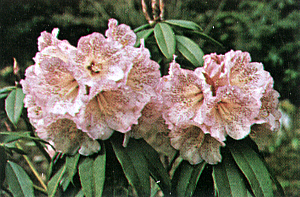Rh. irroratum var. 'Polka Dot'
Carl H. Phetteplace, M.D., Eugene, Ore.

|
|
R. irroratum
'Polka Dot' A.M
The Exbury form in Dr. Phetteplace's garden. Photo by Dr. Carl Phetteplace |
Although there are over 20 rhododendron species listed in the Irroratum Series there are very few, to my knowledge, grown in our gardens. I have seen only Cecil Smith's little jewel captured from the last Dr. Rock expedition, which he has registered as "Spatter Paint". It is quite desirable. For years I have heard of R. "Polka Dot" which may be more prevalent than I realize, but have never seen it in our gardens or shows here. From descriptions I was eager to acquire it and finally did so through the goodness of Major Peter Barber, Director of Exbury Estates, who sent me either scions or grafted plants (I have forgotten which) several years ago. The two plants in my garden now are perhaps three feet tall and have flowered generously the past two years. Everything about them is of excellent quality and certainly of unusual flower.
'Polka Dot' is a woody, hardy growing shrub with light olive, elliptical pointed and rather leathery leaves approximately 10.0 cm by 4.0 cm. The mid-rib is grooved and although the leaf is quite glossy, with the lens, a wisp of brown indumentum can be seen in the depths of the groove and there are a few short stalked glands on the 1.5 cm. pedicle. The lower surface is of a much lighter green than the upper, with a prominent mid-rib and quite glabrous. There are up to 15 good-sized flowers in a well shaped truss which are almost clear white, but the entire circumference of the corolla is evenly spotted with countless maroon-red spots. The substance is excellent.
As to the original source, Major Barber tells me that he can only assume this is one of a group of
irroratums
that the late Lionel de Rothschild collected and grew on, but none can match this particular one for beauty.
R. irroratum
var. 'Polka Dot' received an award of merit in 1957. The original plant is reported by Major Barber to be 20 to 25 feet tall and invariably flowers profusely. It consequently is greatly admired by all visitors when in bloom. Unfortunately, it comes forth a little early for the British shows, and perhaps for the same reason I have not seen it here. It is rated H4 in Britain, which is their most hardy rating. Certainly it should be highly satisfactory as a garden plant, pruned if necessary to maintain it in proportion to the size of the home garden, and of course hybridizers would try it with most anything. Personally I would leave it just as it is.